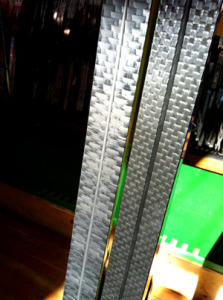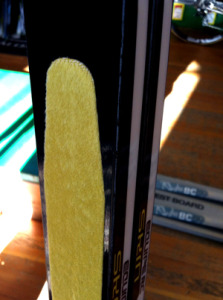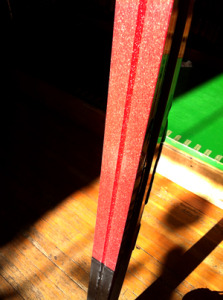
Are you deciding between waxable vs waxless classic cross country skis? You need to know:
- A little about glide wax and kick wax.
- The pros and cons of waxable vs waxless skis.
- The different kinds of waxless skis.
When you know that, you can make 2 important decisions:
- Should you buy waxable or waxless classic cross country skis?
- If you decide on waxless skis, what type should you buy?
Table of Contents
Ski Waxes and Classic Skis
Classic cross country skis are classified as “waxable” or “waxless” based on whether you need to apply kick wax (a.k.a. grip wax) to the ski before you head out onto the trails.
This classification is confusing because even “waxless” skis need to be waxed. Let me explain.
There are 2 broad categories of cross country ski waxes. These waxes are applied to the bases of the skis.
- Glide wax
- Kick wax (a.k.a. grip wax)
Glide Wax
The purpose of glide wax is to protect the bases and help the skis glide better across the snow. Glide wax is applied to waxable and waxless classic skis and to skate skis.
On skate skis, glide wax is applied to the entire length of the ski. On classic skis, glide wax is only applied to the tips and tails of the skis.
Some low cost, entry-level classic cross country skis don’t need any wax treatments, but most cross country skis do need glide waxing to keep the bases in good shape.
To repeat: both waxable and waxless classic cross country skis need glide wax.
Kick Wax
Kick wax, also called grip wax, is only used on waxable classic cross country skis. It’s applied to the base in the midsection of the ski, in the region underfoot.
Kick wax serves to stick to the snow when the skier pushes down to flatten the ski against the snow. This provides the friction the skier needs to push herself forward in classic skiing.
The classification of waxable vs waxless cross country skis only refers to whether the skis need kick wax.
(Want to know more about the mechanics of classic skiing? Watch the first video in this course: Learn Diagonal Stride)
How Waxless Classic Cross Country Skis Work
Waxless, classic skis have of a modified base. The region underfoot, where you would apply kick wax to a waxable ski, is altered in some way to create mechanical grip.
Waxless classic skis are classified according to the type of material that is substituting for the kick wax.
Fishscales

Skin Skis

Zero's

Fishscales
There’s a pattern imprinted on the base of a fishscale ski. That print acts like a stamp that presses into the snow and helps create grip.
Skin Skis
A skin ski has a strip of mohair material inset into the base. The mohair is angled backwards so the material slides easily when the ski is gliding forward. When you push down and back against the ski, the mohairs stick to the snow.
Zero Skis
A zero ski (also called a “rub ski”) has a hard rubber material in the kick zone. You rough it up with sandpaper and apply a spray-on coating that helps the surface stay rough while you ski.
Did you know we have instructional cross-country ski videos?
For skiers just getting started:
- Classic vs Skate Skiing: Which is right for you?
- First Day Lesson for Absolute Beginners
- Help for struggling skate skiers: The One Skate Dance Drill
Pros and Cons of Wax vs Waxless Skis
Advantages of Wax Skis
In general, people who are serious about cross-country skiing use waxable classic skis. That’s because kick wax almost always gives superior performance over the various materials used on waxless skis.
The superior performance comes from the fact kick waxes are infinitely adjustable. There’s a wide range of waxes, even within one brand, and you can select different kick wax for different conditions.
You can fine tune both the grip and glide characteristics of your kick wax. For example, you can layer and lengthen your wax application to adjust your kick and glide.
This sounds more complicated than it is. It doesn’t take long to figure out which waxes work well in your area.
It can be really useful to make these sorts of adjustments and using kick wax almost always results in skis that are faster than waxless skis.
Disadvantages of Wax Skis
- The added cost for buying waxing tools and kick waxes.
- The time it takes to apply and remove grip wax.
- It can feel overwhelming to teach yourself about waxing, especially when you’re new to cross country skiing and have so many other things to learn.
- Difficult waxing days/conditions. (See next.)
Difficult Waxing Days
There are 2 kinds of conditions that make choosing and applying the right kick wax challenging and sometimes even impossible:
- Warm temperatures
- and/or fresh snow.
The kick waxes used on warm days are gooey and sticky. It’s challenging to apply these waxes smoothly. They tend to blob up. They also tend to stick to other things, like clothing.
Klister is a special wax used in warm conditions. Klister, like kick wax, is applied to the kick zone. It’s a sticky goo that squeezes out of a tube, like toothpaste. Like warm temperature waxes, it’s messy.
Fresh falling snow, especially around zero Celsius, is the most challenging situation for kick waxing.
The issue is that fresh snow crystals have sharp edges that embed in kick wax and klister.
Once a tiny ice patch forms in your wax it will seed larger crystals and you’ll end up with big clumps of snow stuck to your skis. The skis won’t glide and it will be frustrating to move forwards.
This can happen at a range of temperatures, but it’s worse at or near zero degrees Celsius.
As it gets warmer it’s less of a problem because the sharp edges on the snowflakes round off from melting.
At colder temperatures it’s less of a problem. The snow still has sharp edges, but cold temperature kick wax is harder. Snowflakes can’t embed as easily in hard wax. Cold temperature waxes are more resistant to icing.
It’s these “unwaxable” conditions that make even diehard cross-country skiers dream of owning waxless skis.
The big disappointment is even waxless skis may ice up in these conditions. That’s why you should always carry an ice scraper in your pocket.
Choosing a Waxless Ski
Skin Ski, Fishscale or Zero?
If all this waxing business sounds like a hassle, then you should opt for waxless skis. You just need to decide which ones.
To make this simple, I’m just going to say, buy skin skis. IMO they are far and away the best choice for the majority of people getting started in cross country skiing.
Even skiers with many pairs of race skis are buying skin skis for training days. The technology is so good that skin skis work across a wide range of conditions.
Skin skis are an easy, grab ‘n go ski and they are a delight to ski on – much nicer than fishscales, imo.
Skin skis have a smoother glide than fishscales. They feel less “rattle-y”. Skin skis also work across an incredibly wide range of conditions and temperatures.
Zero skis are best for competitive skiers. Skin skis are not fast enough for ski races, outside of fun, loppet-style races. A skin ski won’t perform as well in a race situation as a Zero ski.
(A Zero is a bit too complicated for a newer skier to understand and use. It’s not a grab and go ski, like a fishscale or skin ski. That why I don’t recommend zero’s for beginners.)
Learn more about Classic Cross Country Ski Equipment: Classic Cross Country Ski Gear, Explained Simply


